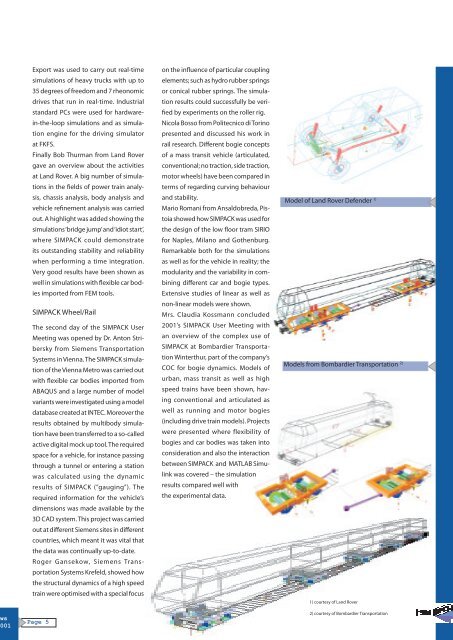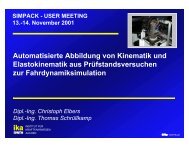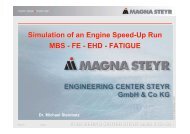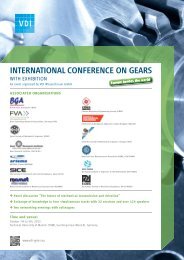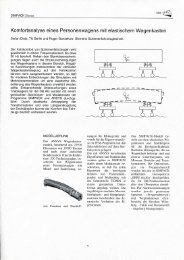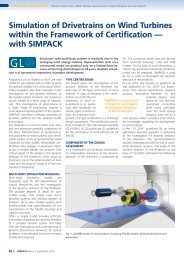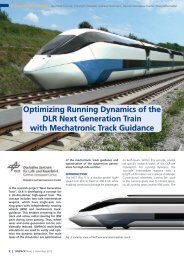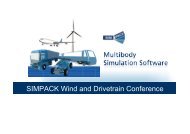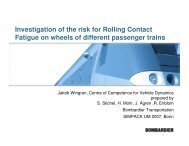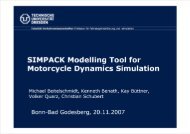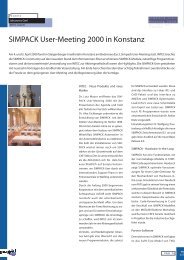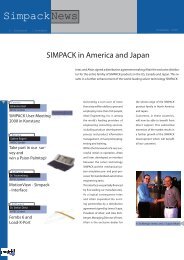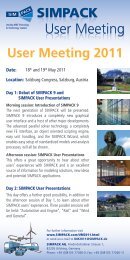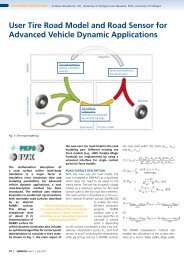SIMPACKNews
SIMPACKNews
SIMPACKNews
You also want an ePaper? Increase the reach of your titles
YUMPU automatically turns print PDFs into web optimized ePapers that Google loves.
ws<br />
001<br />
Export was used to carry out real-time<br />
simu lations of heavy trucks with up to<br />
35 degrees of freedom and 7 rheonomic<br />
drives that run in real-time. Industrial<br />
standard PCs were used for hardwarein-the-loop<br />
simulations and as simulation<br />
engine for the driving simulator<br />
at FKFS.<br />
Finally Bob Thurman from Land Rover<br />
gave an overview about the activities<br />
at Land Rover. A big number of simulations<br />
in the fields of power train analysis,<br />
chassis analysis, body analysis and<br />
vehicle refine ment analysis was carried<br />
out. A highlight was added showing the<br />
simu lations ‘bridge jump’ and ‘idiot start’,<br />
where SIMPACK could demonstrate<br />
its out standing stability and reliability<br />
when performing a time integration.<br />
Very good results have been shown as<br />
well in simulations with flexible car bodies<br />
imported from FEM tools.<br />
SIMPACK Wheel/Rail<br />
The second day of the SIMPACK User<br />
Meeting was opened by Dr. Anton Stribersky<br />
from Siemens Transportation<br />
Systems in Vienna. The SIMPACK simulation<br />
of the Vienna Metro was carried out<br />
with flexible car bodies imported from<br />
ABAQUS and a large number of model<br />
variants were investi gated using a model<br />
database created at INTEC. Moreover the<br />
results obtained by multibody simulation<br />
have been trans ferred to a so-called<br />
active digital mock up tool. The required<br />
space for a vehicle, for instance passing<br />
through a tunnel or entering a station<br />
was calculated using the dynamic<br />
results of SIMPACK (”gau ging”). The<br />
required information for the vehicle’s<br />
dimensions was made available by the<br />
3D CAD system. This project was carried<br />
out at different Siemens sites in different<br />
countries, which meant it was vital that<br />
the data was continually up-to-date.<br />
Roger Gansekow, Siemens Transportation<br />
Systems Krefeld, showed how<br />
the struc tural dynamics of a high speed<br />
train were optimised with a special focus<br />
Page 5<br />
on the influence of particular coupling<br />
elements; such as hydro rubber springs<br />
or conical rubber springs. The simulation<br />
results could successfully be verified<br />
by ex periments on the roller rig.<br />
Nicola Bosso from Politecnico di Torino<br />
presented and discussed his work in<br />
rail research. Different bogie concepts<br />
of a mass transit vehicle (articulated,<br />
con ventional; no traction, side traction,<br />
motor wheels) have been compared in<br />
terms of regarding curving be haviour<br />
and stability.<br />
Mario Romani from Ansaldobreda, Pistoia<br />
showed how SIMPACK was used for<br />
the design of the low floor tram SIRIO<br />
for Naples, Milano and Gothenburg.<br />
Remark able both for the simulations<br />
as well as for the vehicle in reality; the<br />
modularity and the variability in combining<br />
different car and bogie types.<br />
Extensive studies of linear as well as<br />
non-linear models were shown.<br />
Mrs. Claudia Kossmann concluded<br />
2001’s SIMPACK User Meeting with<br />
an overview of the complex use of<br />
SIMPACK at Bombardier Transportation<br />
Winterthur, part of the company’s<br />
COC for bogie dynamics. Models of<br />
urban, mass transit as well as high<br />
speed trains have been shown, having<br />
conventional and arti culated as<br />
well as running and motor bogies<br />
(including drive train models). Projects<br />
were presented where flexibility of<br />
bogies and car bodies was taken into<br />
consideration and also the interaction<br />
between SIM PACK and MATLAB Simu-<br />
link was covered – the simulation<br />
results compared well with<br />
the experimental data.<br />
Model of Land Rover Defender 1)<br />
Models from Bombardier Transportation 2)<br />
1) courtesy of Land Rover<br />
2) courtesy of Bombardier Transportation


